Diseases and pests of pelargonium: causes and treatment
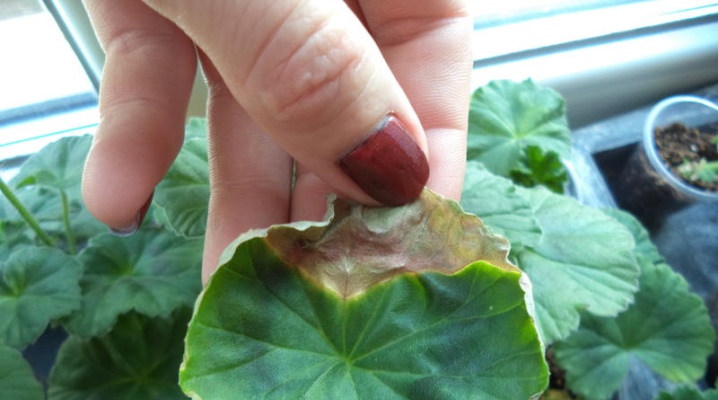
Pelargonium, or indoor geranium, is not a capricious plant. However, troubles such as yellowness on the leaves, spots or siege by insect pests happen to her. You should know how to help your indoor pet and make him healthy.
Name features
Descending from the same Geranium family, pelargonium with geraniums have external similarities, but belong to different genera. Pelargonium has about 300 species of flowering herbaceous plants-shrubs, including the usual geranium, which we incorrectly call, which is more correctly called pelargonium.
Modern botanists are of the opinion that pelargonium is the closest relative of geranium, although earlier it was attributed to a different genus... The confusion over the names of plants occurred when one scientist of the 18th century ranked both plants as different genera, and the second, his contemporary, united them almost simultaneously with him. The spectacular pelargoniums, popular at that time among the nobility, were mistakenly called geraniums. Today it is allowed to call pelargonium room geranium, and geranium flowering shrubs are recommended to be grown in garden plots. Both plant names can be considered synonymous.
Among the significant differences between the two relatives, it is important to note that garden geranium is a perennial, it does not need to be dug up for the winter season or covered on the site, it does not require additional feeding and grows well in shady arid zones. Pelargonium requires more gentle conditions. The garden species of pelargonium is an annual and requires digging, and the indoor representatives, of which the majority, love the southern direction, timely feeding and abundant light, without which they can stop blooming

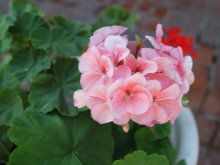
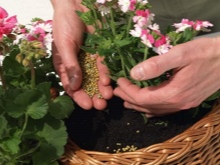
Diseases and treatment
Because of the confusion in the name, many growers do not know how to properly handle pelargonium, and not geranium. From here unsatisfactory growth and diseases of this indoor flower may occur: leaves dry or turn yellow, brown spots appear on them, or insect pests start. However, you can avoid diseases, poor growth in an apartment or on a balcony. Let's try to deal with each cause of the trouble in more detail.
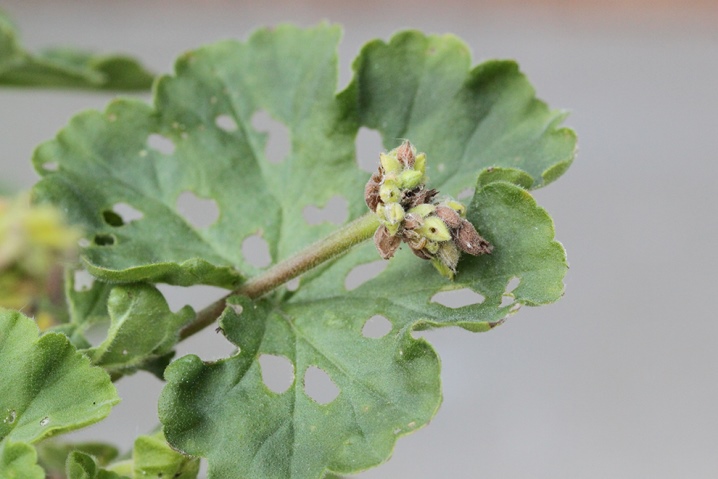
Leaf color change
The yellowness of the leaves with their subsequent withering away is a natural process of life for pelargonium, but you should take a closer look if the leaves of the flower often turn yellow. After all, their intensively changing color is a clear sign of the uncomfortable state of the plant. If the leaves of a room geranium turn yellow, or it has dropped them, you should pay attention to some factors.
- Overflowing or underfilling moisture. When underfilled, the edges of the leaves will darken and brown spots will appear on them. With abundant watering, yellowness will appear at the top: at the cutting of a leaf, the root collar often rots. The intensity of the supply of moisture to the flower is regulated depending on the season: in winter, watering is carried out less often.
- The yellow color of the foliage of pelargonium indicates too hard water, which calcifies the soil.
- Humid indoor air above 20 ° C, as well as too dry and hot, also causes yellowing of indoor geranium foliage. Usually it is not sprayed, but the optimal humidity in the room is monitored: 40-50% at a temperature of 16-23 ° C.Cold is dangerous for pelargonium, and already below + 5– + 6 ° С it begins to turn yellow, its leaves fall off, and then it dies at home. Although in winter at a temperature of + 7– + 10 °, indoor geranium feels great.
- Excessive air vibrations, drafts. Indoor geraniums should not be placed in ventilated places.
- Pelargonium roots are cramped in a pot. Indoor geraniums need sufficient space in the container, since they have a well-developed root system that requires a certain amount of nutrients. But an unnecessarily spacious container can slow down the flowering of the plant and provoke stagnation of moisture.
- Abundance or lack of mineral fertilizers. It is necessary to observe the norms of feeding the plant, and also to avoid any contact of pelargonium with herbicides, after which its leaves turn yellow and dry.
- Direct excessive sunlight, as well as a lack of illumination, will cause the leaves of this flower to turn yellow.
The lower leaves of indoor geranium may turn yellow after transplanting it into a new planter, this is considered the norm.
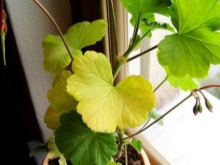
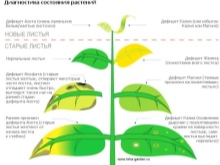
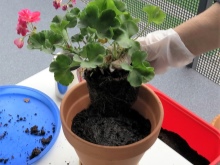
Diseases
If all the conditions of detention correspond to the standards, you should think about whether indoor geranium is sick. Among the common diseases of pelargonium, there are several.
- Fungal Alternaria It is manifested by brown spots and yellowness. With high humidity, a brown bloom appears on the spots. If the soil in the pot is allowed to dry well, and then sprayed with fungicides, pelargonium can be reanimated.
- Withering is verticillous. Description of symptoms: yellowness of the lower leaves of pelargonium. Due to a progressive disease, the entire plant disappears. In this case, the complete elimination of watering and a complete replacement of the soil will help.
- Rot is gray. In addition to the fact that the leaves wilt and turn yellow, rotting gray spots and velvety bloom appear on them. To fight the disease is necessary only by transplanting room geraniums into ceramic or earthenware (not plastic) with replacing the earth and installing the flower in a bright place. The affected areas of the plant must be removed, and the cut sites must be powdered with ash.
- Rhizoctonia rot. It is recognized by dark spots pressed into the leaves and stem. Later, gray mold is visible on the spots. Treatment of a flower at home is carried out with the complete exclusion of watering and soil treatment with Granozan.
- Rust. Its signs are the appearance of reddish-brown spots on the surface of the leaves, which subsequently wither and fall off. In this case, moving geraniums to a room with dry air, reducing the frequency of watering and treating the soil with fungicides will help.
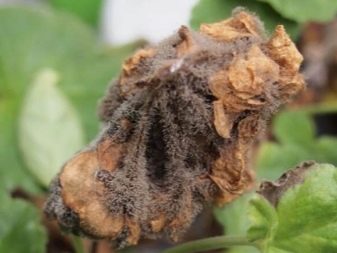

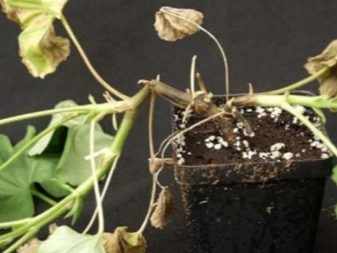
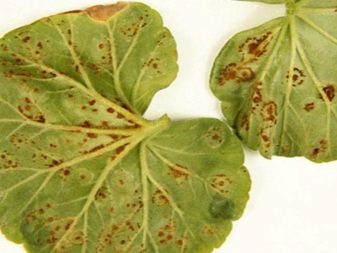
Pests
Pelargonium is often planted on balconies or used to decorate building facades. A plant in the open air can be attacked by various pests.
- A winged insect similar to a midge or moth - the whitefly - can settle on the inside of the sheet. For pelargonium, it is a parasite, since both adults and larvae feed on plant sap. If the whitefly is not noticed in time, the indoor geranium will quickly die. It is necessary to manually collect all whiteflies, and treat the plant with insecticides at intervals of 2-3 weeks.
- Insecticides are also an important helper in the fight against aphids. The plant attacked by aphids folds the leaves, acquiring yellowness, inward. It is important to notice aphids in time and get rid of them not only with the help of chemicals, but also with old proven means: soap solution or solution with ash. The diseased leaves from the flower should be removed.
- Spider mite. It is also a parasite that feeds on pelargonium juice. The appearance of a spider mite is characterized by the formation of small dots on the foliage and discoloration of small flower fragments. Spider mites should be fought by treating pelargonium with insecticides at regular intervals. This should be done in the evening in dry, calm weather.
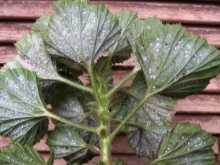
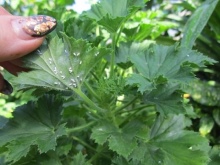

Prophylaxis
So that the beautiful flowers of room geranium constantly delight their owner, and the foliage is healthy and does not turn yellow, in caring for pelargonium, it is important to follow simple but important rules.
- Choose a southwest or southeast direction when placing the flower, as southern abundance of the sun can yellow and dry out the lower leaves, as can a lack of light on the north side. The room should be with good air ventilation, but there should be no draft on the flower.
- Create the optimal temperature in the room, where at night + 14– + 16 ° С, and during the day not higher than + 20– + 23 ° С. In winter, it can be taken out on a bright veranda with cool air + 7– + 12 ° С. In winter, pelargonium also requires additional lighting. If the room has dry air with humidity below 40%, place dishes with water nearby. Indoor geranium is not sprayed.
- Water as needed, focusing on the slightly dried topsoil. It should be watered especially carefully in the cold season to avoid rotting of the plant root and yellowing of the leaves.
- Monitor the hardness of the water using only settled moisture and, if necessary, soften it with a pinch of citric acid.
- It is imperative to lay a drainage layer in the container in which the pelargonium will live. Sand is not suitable for it, it is better to choose a special drainage and a substrate containing peat in a specialized store.
- The container for pelargonium should not be plastic, it is better to choose breathable ceramics or clay.
- The size of the pot should not constrain the root system of the plant. The optimal size is a radius of 15–20 cm from the stem of the flower and 10 cm deep from the bottom of the root.
- If a fungal disease, rot is detected, the flower is restored by systemic treatment with fungicides.
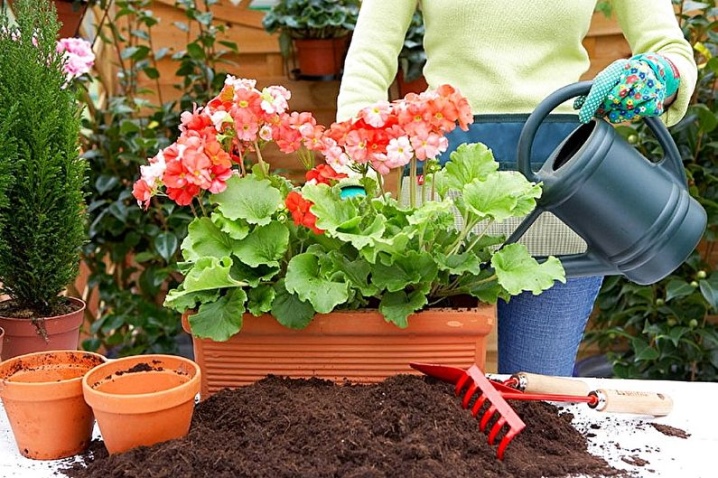
Carefully examine the leaves: are there any midges, spider mites, other pests, and if they are found, immediately apply soapy water or insecticides. Fertilize flowering pelargonium with liquid mineral dressing no more than every 2 weeks.
For information on how to cure pelargonium from most diseases, see below.

























The comment was sent successfully.